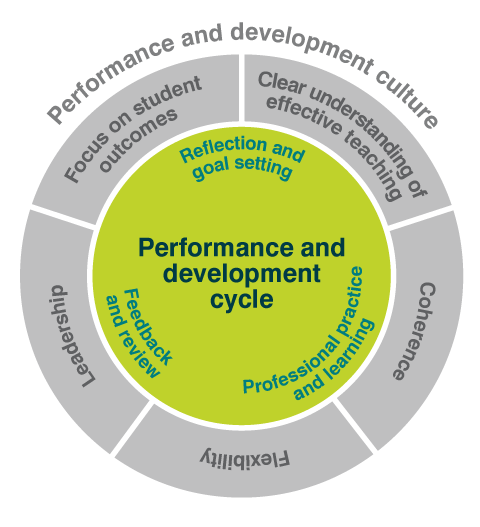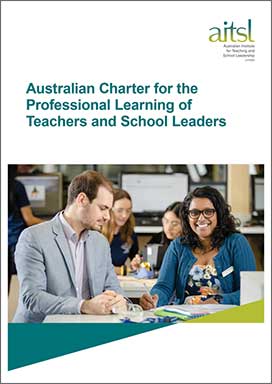Reflection
Which of the benefits listed above would make the biggest difference in your education setting?
Focus on student outcomes. Improving teaching is not an end in itself, but it is aimed at improving outcomes for learners. The Framework defines student outcomes broadly to include student learning, engagement in learning, and wellbeing.
These can be measured in a variety of ways.
Clear understanding of effective teaching. The Australian Professional Standards for Teachers (the Standards) outline what teachers should know and be able to do at four career stages. The Standards provide the basis and a common language
for coming to a shared understanding of what effective teaching looks like, in the context of a particular education setting at a particular time.
Leadership. Research is clear on the critical role of leaders in creating a culture of performance and development. While principals have a central role, a truly effective approach has a shared commitment from teachers for their own –
and each other’s – development.
Flexibility. All education settings have different contexts and histories. There isn’t a one-size-fits-all approach, and performance and development will look different across unique settings.
Coherence. Goals and processes should reflect the overall approach to teaching and learning within an education setting and should be consistent with the existing plans and approaches.
Reflection
Identify existing processes within your education setting that support the five components of a performance and development culture.
| Component | Examples |
|---|
| Focus on student outcomes | |
| Clear understanding of effective teaching | |
| Leadership | |
| Flexibility | |
| Coherence | |
Education settings operate in different contexts and will have different starting points, with differing implementation needs.
It is in the ongoing work of implementation and culture change that the real challenge lies. There needs to be a strong commitment from, and extensive support for:
- education settings
- groups of education settings
- teachers
- leaders
- the wider education setting community.
Monitoring and evaluation are also essential to sustained and successful implementation.
Reflection
What opportunities and potential barriers can you see in building on the performance and development culture within your education setting? How can you improve the processes currently in place?
Professional conversation
After spending time reflecting individually, seek out a colleague, mentor or leader to discuss your thoughts. Use the above questions and your responses to help structure the conversation.
The teacher performance and development cycle provides a structure for developing and refining teaching practice. The three components of the cycle are interdependent and may not necessarily occur in a set order, or take equal time, but the cycle provides a useful
way to structure your thinking about how to improve practice. The components are highlighted in light green here:

Reflection and goal setting, with regular reviews of measurable goals. Goals should align to an education setting’s shared view on effective teaching and should take teacher reflection into account.
Professional practice and learning, meaning teachers will make a conscious effort to collect and reflect on evidence. It should occur in a context of frequent formal and informal feedback.
Feedback and review, with feedback being timely, frequent and improvement focused. There should also be a formal annual performance and development review, including a full reflection on a teacher’s performance against their goals
using multiple sources of evidence.
Reflection
Identify existing processes within your education setting that support the three performance and development cycle practices outlined in the Framework.
| Components | Examples |
|---|
| Reflection and goal setting | |
| Professional practice and learning | |
| Feedback and review | |
There are four elements essential to an effective cycle of performance and development. These have been distilled from the research, practitioner advice and an analysis of current good practice.
Goal setting: All teachers have a set of documented and regularly reviewed goals related to both performance and development, and ways of measuring progress towards them, that are agreed with leadership.
Professional support: All teachers are supported in working towards their goals, including through access to high-quality professional learning.
Evidence collection: Evidence used to reflect on and evaluate teacher performance, including through the formal review described in ‘Feedback and Review’, should come from multiple sources and include as a minimum: data showing
impact on learner outcomes; information based on direct observation of teaching; and evidence of collaboration with colleagues.
Feedback and review: All teachers receive regular formal and informal feedback on their performance. This includes a formal review against their performance and development goals at least annually, with verbal and written feedback being
provided to the teacher.
Teachers, leaders, principals, systems and sectors have a shared responsibility to implement effective performance and development.
- Development should be well aligned with other policies and processes at the national, jurisdiction, system and education setting level. It should also reflect the needs and aspirations of the wider education setting community.
- Development should support career progression, including through formal processes such as promotion and certification as a Highly Accomplished or Lead teacher.
- Monitoring and evaluation, including feedback from the education setting community, fosters a sustained and successful implementation.
- Understanding of Indigenous perspectives and knowledge is critical to engage effectively with Aboriginal and Torres Strait Islander colleagues, learners, families, and communities. Leaders play an important role in monitoring where individual teachers
and whole settings are on their continuum of cultural responsiveness.
The Charter outlines what makes professional learning effective so it leads to improved learner outcomes in Australia.

The Charter was informed by research, national and international experts, and extensive consultation with professional associations and the broader education community.
It works alongside the Framework to help teachers and leaders build a successful growth culture.
Professional learning should support teachers to reflect on, question and consciously improve their practice. It is most effective when it is:
- relevant
- collaborative
- future-focused
Professional learning is most effective when it takes place within a culture where teachers and leaders:
- expect and are expected to be active learners,
- reflect on pedagogical practice
- receive feedback on and improve their pedagogical practice.
In embedding high quality professional learning practices within education settings, teachers and leaders work together to improve student outcomes. Ongoing learning is essential for teachers throughout their careers, to ensure they meet the current learning needs and aspirations of the diverse learners they teach and the diverse communities they work in.
These characteristics of effective professional learning should be considered when selecting, reflecting on, or evaluating professional learning.
Professional conversations
Identify a colleague, leader or mentor to work through the Charter Stimulus cards.
National frameworks
Resources about the Australian Teacher Performance and Development Framework
Resource for leaders
Access videos and stories about real leaders developing leadership using both the Teacher Standards
and Principal Standard.
Deepen your understanding with:
Read:
Get into more detail about the development cycle with
If you haven’t already, complete:
Alternatively, return to the